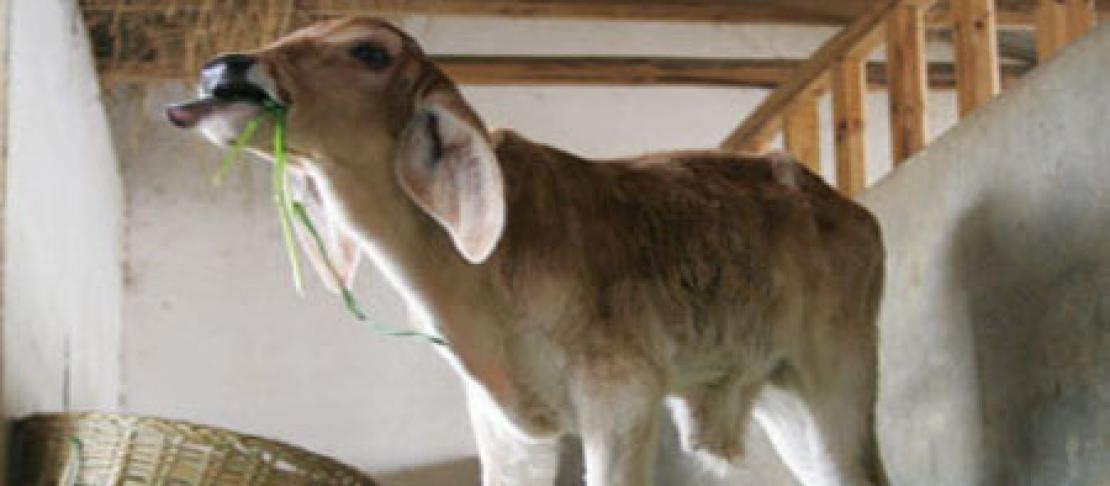Shrinking the environmental footprint of livestock in China

Project description
Already the largest livestock producer in the world, China’s livestock sector is booming. And so are emissions: national methane emissions from livestock have more than tripled since 1980. Policy-makers in China are increasingly concerned with how to curb the environmental impacts of livestock, including climate change, and have thus set an ambitious target to reduce carbon dioxide emissions per unit of gross domestic product (GDP) by 18%. To this end, Chinese researchers, government officials and companies are working with the CGIAR Research Program on Climate Change, Agriculture and Food Security (CCAFS), the Sino-Dutch Dairy Development Centre (SDDDC), Wageningen University & Research (WUR) and the Global Research Alliance on Agricultural Greenhouse Gases (GRA) to improve:
- tracking emissions from livestock; and
- assessment of climate impacts of improved livestock management practices.
Two types of assessments are being developed: a tool that can assess emissions from improved livestock practices at the dairy farm level and advanced emission accounting methods (Tier 2) so that provincial governments can contribute high quality data to national reports.
Activities
Carbon Footprint Assessment and Mitigation Options of Dairy under Chinese Conditions: Chinese and Dutch research institutions, CCAFS and the private sector are working together to identify locally relevant sustainable dairy practices, especially from novel feeds, and provide accurate estimates of emissions and emission reduction options from changes in dairy practices. The expectation is that global best practices and feed innovations, such as lignin degradation of maize or rice straw, will help reduce emissions from dairy in China. Together, the team will develop a model and tool that can evaluate the carbon footprint of dairy cattle and provide information about which practices can reduce the carbon footprint and simultaneously benefit farmers, consumers, and the environment.
- Workshop: Kick-off meeting on "Piloting and scaling of low emission development options in large-scale dairy farms in China"
- Introduction of workshop presentation
- Project implementation plan: Piloting and scaling of low emission development options in large scale dairy farms in China
New Zealand dairy sector greenhouse gas emissions: current and future reductions
Reduction of GHG and nitrogen emissions from dairy production systems
Outputs:
- Presentation: Carbon footprint assessment and mitigation options of dairy under Chinese conditions: Implementation plan
- Report: Carbon Footprint Assessment and Mitigation Options of Dairy under Chinese Conditions
- Report: Tier 2 MRV of Livestock Emissions in China: Developing Guidance for Implementation at the Provincial Level: Partners in this project aim to develop practical guidance and build capacity in advanced (Tier 2) methods to improve measurement, reporting and verification (MRV) of greenhouse gas emissions and emission reductions at the province level. The project focuses on major livestock-producing provinces and important livestock categories, including enteric fermentation and manure management from dairy cattle and pigs. Newly developed methods and systems for Tier 2 MRV of livestock emissions will be tested in Hebei Province, China, using results to develop methods that can be used to support Tier 2 MRV elsewhere.
Expected outcomes
- Global best practices and feed innovations, such as lignin degradation of maize or rice straw, will help reduce emissions from dairy in China.
- Tier 2 methods to improve MRV scaled up
Partners
- China Agricultural University (CAU)
- Chinese Academy of Agricultural Sciences (CAAS)
- Food and Agriculture Organization (FAO)
- Global Research Alliance for Agricultural Greenhouse Gases (GRA)
- Hebei Green Agriculture Limited Company
- Hebei Provincial Livestock Technology Extension Station
- National Center on Climate Change Strategy and International Cooperation (NCSC)
- Sino-Dutch Dairy Development Corporation (SDDDC)
- United States Agency for International Development (USAID)
- Wageningen University & Research (WUR)
More information
For more information, please contact Lini Wollenberg, CCAFS (lini.wollenberg@uvm.edu).